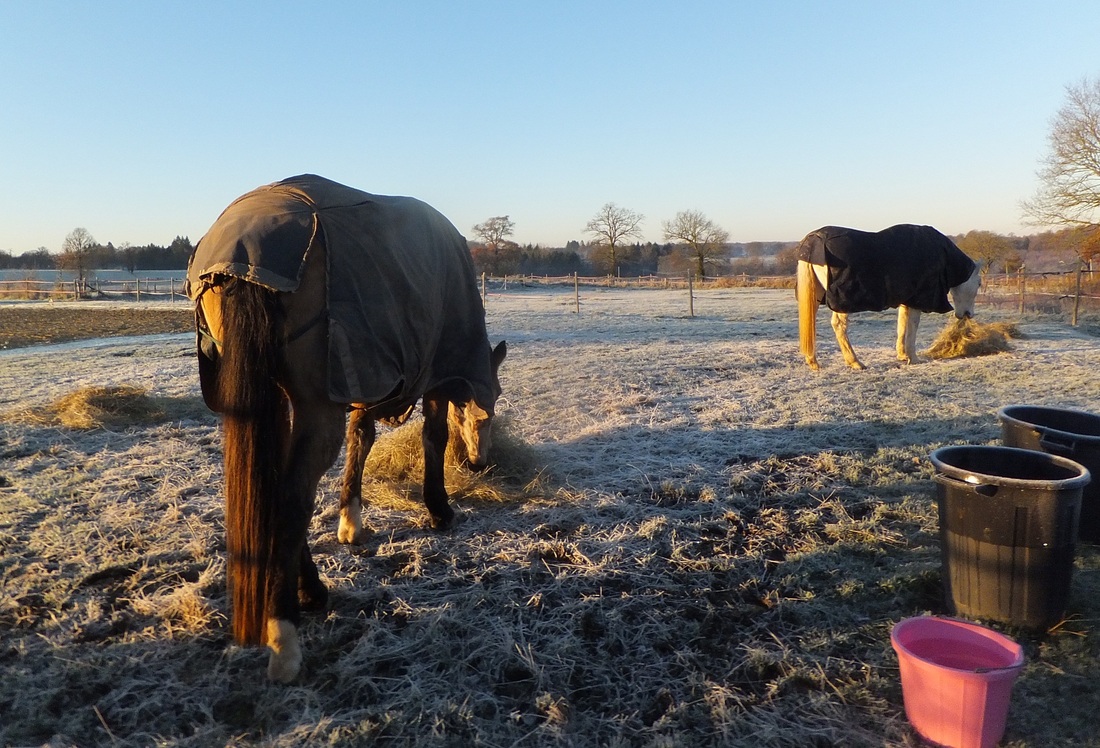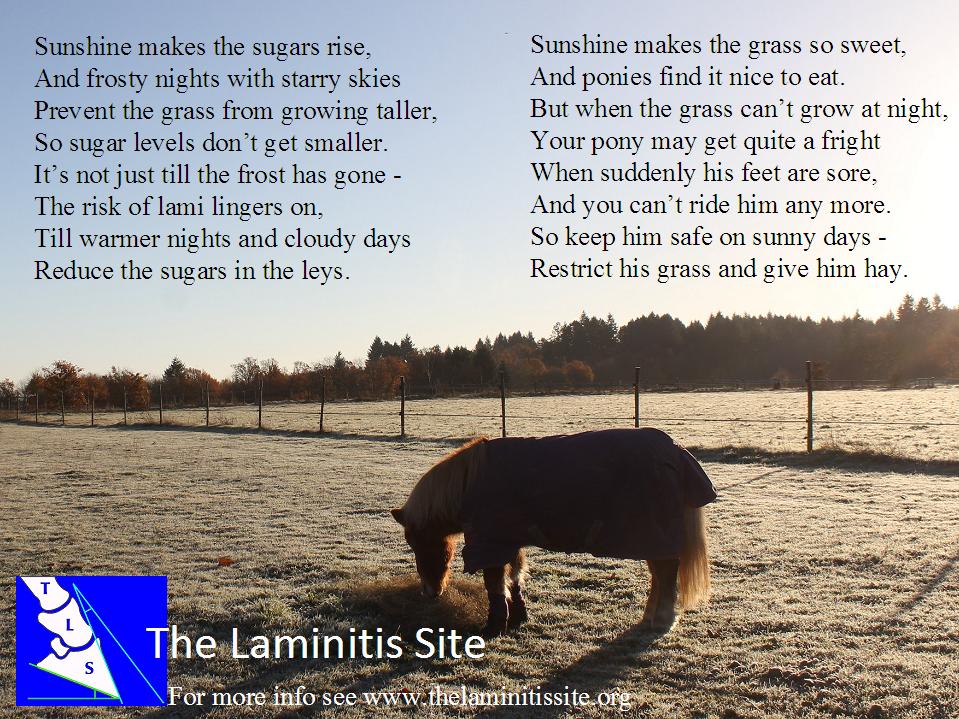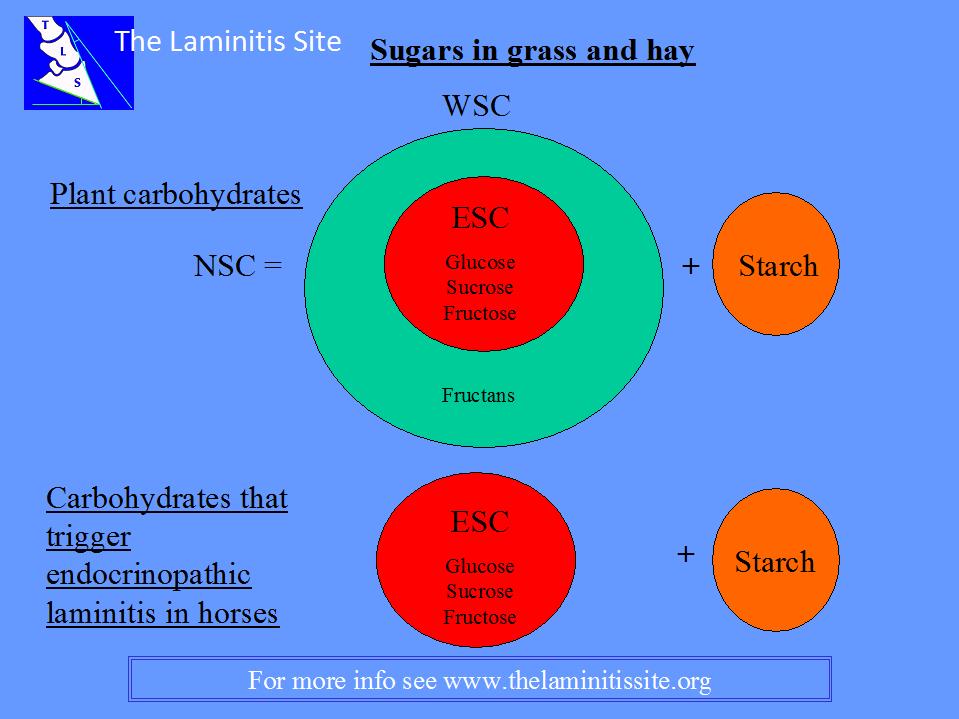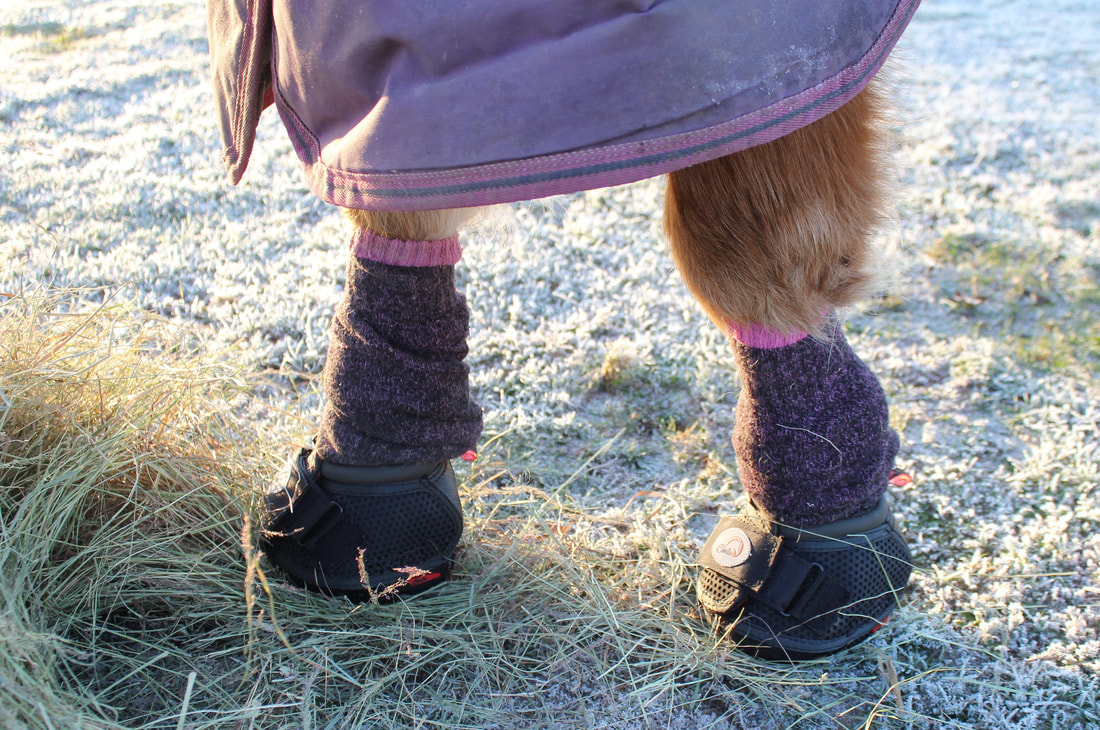|
Cold weather often seems to trigger laminitis - we usually see an increase in laminitis cases as soon as the weather turns cold (snow/ice/frost) each winter.
Frosty weather may be beautiful but sunny days with cold frosty nights cause sugars to accumulate in the grass. People often think that laminitic horses shouldn't graze frosty grass until the sun has melted the frost, but that's not exactly correct - they shouldn't graze the grass until there has been a return to night time temperatures above 5'C and/or overcast weather. |
During sunny weather grass makes and stores sugars (photosynthesis), at night when grass is able to grow these sugars are used up (respiration), but when environmental conditions such as low temperatures (below around 6'C), lack of rainfall or poor fertility prevent growth, sugar (ESC) levels can continue to accumulate in the grass, making it unsuitable for horses and ponies with insulin dysregulation and increasing the risk of laminitis.
"Ideal conditions for high NSC concentrations are clear skies to maximise photosynthesis, and low night temperatures to minimise loss of carbohydrates through respiration (Fulkerson et al. 1998)" - from: Non-structural carbohydrate content of a perennial ryegrass cultivar bred for high sugar levels, compared to "normal" perennial ryegrass and white clover; Francis et al., Anim. Prod. Aust. 2002 Vol.24:73-76
See:
When is dead grass safer to graze? - Kathryn Watts
Factors affecting NSC levels in grass - Kathryn Watts
"Ideal conditions for high NSC concentrations are clear skies to maximise photosynthesis, and low night temperatures to minimise loss of carbohydrates through respiration (Fulkerson et al. 1998)" - from: Non-structural carbohydrate content of a perennial ryegrass cultivar bred for high sugar levels, compared to "normal" perennial ryegrass and white clover; Francis et al., Anim. Prod. Aust. 2002 Vol.24:73-76
See:
When is dead grass safer to graze? - Kathryn Watts
Factors affecting NSC levels in grass - Kathryn Watts
Grass facts
Green plants create sugar through the process of photosynthesis.
carbon dioxide + water + sunlight = sugar + oxygen
Plants use the sugar for growth and reproduction - this process is called respiration.
glucose + oxygen = carbon dioxide + water + energy for growth/respiration
When sugar production from photosynthesis > sugar required for growth/reproduction, the excess sugar is stored as fructan or starch (carbohydrates) for later use.
Plants respire all the time, in darkness and in light, but only photosynthesize in light. Increased light leads to increased photosynthesis (up to a point).
No light/darkness: respiration > photosynthesis (there is no photosynthesis without light).
Dim light: photosynthesis = respiration.
Bright light: photosynthesis > respiration.
Grass hardly grows (respires) when temperatures are below 5 degrees C.
Plant carbohydrates are classified as:
Ethanol Soluble Carbohydrates (ESC) - this is the sum of the simple sugars, particularly glucose, fructose, sucrose. ESC causes glucose and therefore insulin to rise when eaten by horses.
Water Soluble Carbohydrates (WSC) - this is the sum of ESC plus fructans. Fructans do not affect glucose and insulin when eaten by horses.
Starch - horses digest starch in the stomach and small intestine to glucose, and glucose causes blood glucose and therefore insulin to rise when eaten by horses.
Non-Structural Carbohydrates (NSC) - this is the sum of WSC plus starch.
Only ESC and starch are important when talking about horses and endocrinopathic laminitis.
Green plants create sugar through the process of photosynthesis.
carbon dioxide + water + sunlight = sugar + oxygen
Plants use the sugar for growth and reproduction - this process is called respiration.
glucose + oxygen = carbon dioxide + water + energy for growth/respiration
When sugar production from photosynthesis > sugar required for growth/reproduction, the excess sugar is stored as fructan or starch (carbohydrates) for later use.
Plants respire all the time, in darkness and in light, but only photosynthesize in light. Increased light leads to increased photosynthesis (up to a point).
No light/darkness: respiration > photosynthesis (there is no photosynthesis without light).
Dim light: photosynthesis = respiration.
Bright light: photosynthesis > respiration.
Grass hardly grows (respires) when temperatures are below 5 degrees C.
Plant carbohydrates are classified as:
Ethanol Soluble Carbohydrates (ESC) - this is the sum of the simple sugars, particularly glucose, fructose, sucrose. ESC causes glucose and therefore insulin to rise when eaten by horses.
Water Soluble Carbohydrates (WSC) - this is the sum of ESC plus fructans. Fructans do not affect glucose and insulin when eaten by horses.
Starch - horses digest starch in the stomach and small intestine to glucose, and glucose causes blood glucose and therefore insulin to rise when eaten by horses.
Non-Structural Carbohydrates (NSC) - this is the sum of WSC plus starch.
Only ESC and starch are important when talking about horses and endocrinopathic laminitis.
Other reasons for horses to show signs of laminitis/foot discomfort in cold weather may include:
- circulation damage, or ongoing damage in the feet from rotation that hasn't been corrected making feet more sensitive to hard frozen ground,
- horses with PPID lose their ability to thermoregulate, therefore get more stressed by extreme temperatures, which could increase cortisol,
- hay soaking is not as effective at colder water temperatures,
- horses tend to get less exercise/turnout in cold/frosty/snowy weather.
What you can do:
- prevent or limit access to grass during and after sunny frosty weather until the weather changes to milder nights and overcast days, and feed analysed hay with sugar and starch levels below 10% instead. It is not the frost itself that is the risk, it is the weather conditions that cause the frost, so do not allow horses to graze once the frost has melted with the sun - wait until the grass has been able to respire and use up some of its sugar.
- keep feet warm and protected - use leg wraps/bandages, pads and boots on feet, warm deep bedding. Thick wool hiking socks can be great for keeping pony feet and legs warm.
- ensure feet are well trimmed/balanced - even the slightest tipping of the pedal bone onto the sole by high heels or pull on the laminae by long toes can exacerbate pain and discomfort when a horse is walking on hard rough ground.
- rug well, provide good shelter out of the wind/weather - particularly PPID/underweight horses. For overweight/EMS horses, cold weather can encourage weight loss so consider whether they really need a thick rug.
- soak hay in warm water.
- cut back feed (calories, not fibre) if exercise/turnout is reduced.
- provide warm water for drinking to reduce the risk of impaction colic (not such a great risk when soaking hay) - particularly for older/PPID horses that might have tooth problems.
See:
Winter Laminitis - Dr Eleanor Kellon 2018
Cold weather - The Laminitis Site
- rug well, provide good shelter out of the wind/weather - particularly PPID/underweight horses. For overweight/EMS horses, cold weather can encourage weight loss so consider whether they really need a thick rug.
- soak hay in warm water.
- cut back feed (calories, not fibre) if exercise/turnout is reduced.
- provide warm water for drinking to reduce the risk of impaction colic (not such a great risk when soaking hay) - particularly for older/PPID horses that might have tooth problems.
See:
Winter Laminitis - Dr Eleanor Kellon 2018
Cold weather - The Laminitis Site





 RSS Feed
RSS Feed